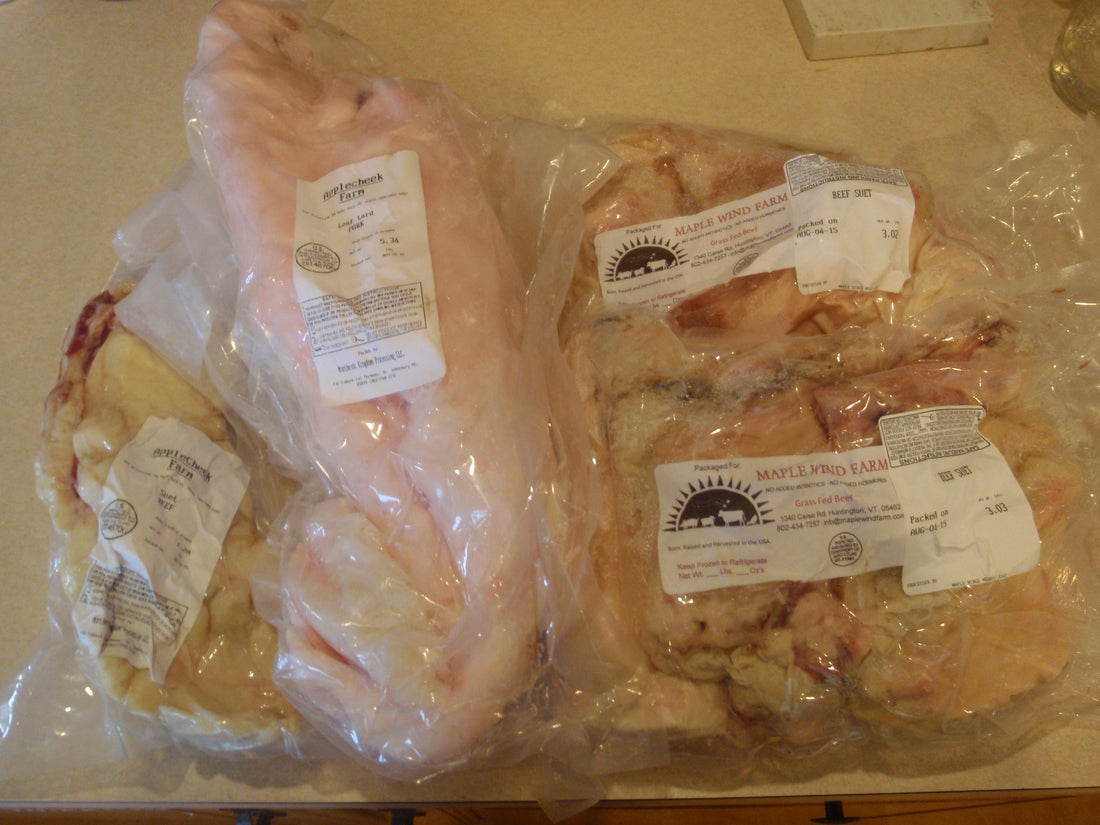
Lard and Tallow - What's the difference?
Share
Animal fats are far less common in our daily lives than in the past and in recent decades there has been a push to remove them from not only our diets but from our skin products. The result is that most people today are not very familiar with the different types and uses of animals fats. Did you know that prior to the widespread use of petroleum products, animal fats were used for anything from candles to axle grease, not to mention forming an important part of the diet.
Here at Fat Chance Farm, we are, of course, big proponents of using animal fats! (though maybe not on our tractor axles...) Fat is a natural part of any animal, so finding ways to use it and not let it go to waste is an important part of eating meat ethically. One can only eat so much fat, however, no matter how keto your diet is. So, what better way to put Vermont's excess of ethically raised, pastured animal fats to use than to make soap!
Lard
So what is lard? Historical definitions may vary a bit but when I use "lard" it specifically means fat from pigs. Pigs are very good at putting on fat, which means they have fat both under the skin and internally. The internal fat that surrounds the organs is known as "leaf lard" and in most mammals is concentrated around the kidneys. Leaf lard is the hardest, whitest fat on the pig but it is still much softer than tallow, leaf lard is prized for baking and is great for soap making!
Below you can see a large chunk of leaf lard next to several packages of beef fat for comparison. You can see how the fat from grass fed cows has a slight yellow color. This is because of how cows store carotene (vitamin A) from the grass they eat. Animals like pigs don't do this, so the leaf lard is brighter white, no matter what their diet is.

Back fat is the fat under the skin. This fat is softer and more off-white and is more often used in cooking rather than baking but is also great for making soap. Did you know that some heritage breeds of pigs are considered "lard breeds"? Before the production of plant based cooking oils, lard was in hot demand, so the more fat you could get from a pig the better!
Tallow
Tallow is defined by the fact that it is a very hard fat at room temperature. The melting point of tallow is often up around 100f! This contributes a long lasting hardness to a bar of soap. It also has a very high "smoke point", which was a big part of its popularity as a frying oil before other options came along.
What is it, though? Technically, tallow is the fat from any hooved ruminant mammal but in our case, we use only beef tallow in our products. This is simply because it is much easier to get large amounts of grass-fed beef tallow than sheep, goat or deer! So when I refer to cows here, what I'm saying is typically true for sheep and goats etc. as well.
Unlike pigs, cows do not store fat under their skin, the main source of tallow is the internal fat around the kidneys. The other place you will see fat is in the "marbling" on steaks and other cuts but that is best left where it is (fat is a big part of what makes steaks tasty!) A well marbled beef cow can produce upwards of 30lbs of tallow, that's a lot of soap!

Another term you may hear in reference to beef fat is suet. Suet is any hard fat like beef tallow before it has been rendered. Rendering is the process of turning raw chunks of fat like you see above, into a smooth, consistent, melt-able product. Put simply, rendering means cooking the fat down on low heat until all the moisture is driven out and the fat has separated from any remaining meat or connective tissue and then filtering it. This process is also used for lard but since lard is a softer fat it is not called suet in its raw state. Why? That's a question for the language gods.
Other Fats
There are some other fabulous animal fats out there but they are often either better used for cooking or just don't occur in large enough amounts to make it worth collecting and rendering. I have experiemented in the past with chicken fat in soap (called "schmalz" by some) but I didn't feel it really brought anything special to the table (and if you think people get a little squeamish about lard soap, try telling them you added chicken fat too...) Goose fat is fairly plentiful on each animal but not many people besides me raise geese and I think it's much better put to use roasting potatoes!
